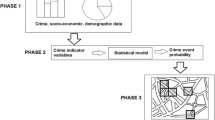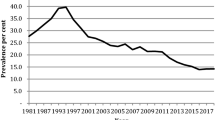Abstract
While evidence-based policing (EBP) contains much promise for law enforcement agencies, implementation is a challenge. Crime analysts are uniquely positioned to help drive EBP within police services. Combining research knowledge with a detailed understanding of police data and analytics, they provide means by which police agencies can not only become increasingly data driven, but also to engage in their own internal research. Numerous examples illustrate this point. Crime analysts have been pivotal to the success of projects in such diverse areas as hotspot policing, focused deterrence, smart policing initiatives and problem-oriented policing, among others. This chapter discusses how analysts can become involved with developing internal evidence-based policing. It will outline how crime analysis has been integrated in policing (current practices and barriers)and how crime analysts can continue to play a key role in the future of evidence-based policing.
Access this chapter
Tax calculation will be finalised at checkout
Purchases are for personal use only
Similar content being viewed by others
References
Atkinson, C. (2016). Patriarchy, gender, infantilisation: A cultural account of police intelligence work in Scotland. Australian & New Zealand Journal of Criminology, 50(2), 234–251.
Belur, J., & Johnson, S. (2018). Is crime analysis at the heart of policing practice? A Case Study. Policing and Society, 28(7), 768–786.
Boba, R. (2010). A practice-based evidence approach in Florida. Police Practice and Research: An International Journal, 11(2), 122–128.
Boba, R. (2013). Crime analysis and crime mapping. Sage Publications, Inc.
Boba, R., & Santos, R. (2011). A police organizational model for crime reduction: Institutionalizing problem solving, analysis, and accountability. U.S. Dept. of Justice, Office of Community Oriented Policing Services.
Boba Santos, R., & Taylor, B. (2014). The integration of crime analysis into police patrol work: Results from a National Survey of law enforcement agencies. Policing: An International Journal, 37(3), 501–520.
Braga, A. A. (2016). The value of ‘pracademics’ in enhancing crime analysis in police departments. Policing: A Journal of Policy and Practice, 10(3), 308–314.
Burcher, M., & Whelan, C. (2018). Intelligence-led policing in practice: Reflections from intelligence analysts. Police Quarterly, 22(2), 139–160. https://doi.org/10.1177%2F1098611118796890.
Chainey, S. (2012). Improving the explanatory content of analysis products using hypothesis testing. Policing. Policing: A Journal of Policy and Practice, 6(2), 108–121.
Chan, J. (2001). The technology game: How information technology is transforming police practice. Criminal Justice, 1(2), 139–159.
Cope, N. (2004). Integrating volume crime analysis into policing. The British Journal of Criminology, 44, 188–203.
Crank, J. P. (1998). Understanding police culture. Anderson Publishing Company.
Dolly, C., & Shawver, B. (2018). The organizational and practical considerations of starting a crime analysis unit: A case study of a midwestern police department. Policing: A Journal of Policy and Practice, 12(3), 255–264.
Eck., J.E. (1998). What do those dots mean? Mapping theories with data. In D. Weisburd & T. McEwen (Eds.), Crime mapping and crime prevention (pp. 379–406). Criminal Justice Press.
Egge, J. (2011). Experimenting with future-oriented analysis at crime hot spots in Minneapolis. Geography and Public Safety, 2(4) National Institute of Justice.
Evans, J., & Kebbell, M. (2012). The effective analyst: A study of what makes an effective crime and intelligence analyst. Policing and Society, 22(2), 204–219.
Evans, J., & Kebbell, M. (2012b). Integrating intelligence into policing practice. In T. Prenzler (Ed.), Policing and security in practice: Challenges and achievements. Palgrave Macmillan.
Huey, L., & Mitchell, R. J. (2016). Unearthing hidden keys: Why pracademics are an invaluable (if underutilized) resource in policing research. Policing: A Journal of Policy and Practice, 10(3), 300–307.
Innes, M., Fielding, N., & Cope, N. (2005). The appliance of science? The theory and practice of criminal intelligence analysis. The British Journal of Criminology, 45(1), 39–57.
Keay, S., & Kirby, S. (2018). The evolution of the police analyst and the influence of evidence-based policing. Policing: A Journal of Policy and Practice, 12(3), 265–276.
Koper, C. S., Lum, C., Willis, J. J., Woods, D. J., & Hibdon, J. (2015). Realizing the potential of technology in policing: A multi-site study of the social, organizational, and behavioral aspects of implementing policing technologies. Report to the National Institute of Justice. Center for Evidence-Based Crime Policy, George Mason University.
Lum, C. (2009). Translating police research into practice. Police Foundation (Ideas in American Policing, Series No. 11).
Lum, C. (2013). Is crime analysis evidence-based? Translational Criminology, 5, 12–14.
Lum, C., & Koper, C. S. (2017). Evidence-based policing: Translating research into practice. Oxford University Press.
Lum, C., Telep, C. W., Koper, C. S., & Grieco, J. (2012). Receptivity to research in policing. Justice Research and Policy, 14(1), 61–95.
Lum, C., Koper, C. S., & Willis, J. (2017). Understanding the limits of technology’s impact on police effectiveness. Police Quarterly, 20(2), 135–163.
MacVean, A., & Harfield, C. (2008). Science or sophistry: Managing analysts and their products. In C. Harfield, A. MacVean, J. Grieve, & D. Phillips (Eds.), The handbook of intelligent policing consilience, crime control, and community safety (pp. 93–104). Oxford University Press.
O’Shea, T., & Nicholls, K. (2003). US Department of Justice – Office of Community Oriented Policing Services. In Crime analysis in America: Findings and recommendations.
Peterson, M. (1990). The context of analysis. In P. Andrews & M. Peterson (Eds.), Criminal intelligence analysis. California.
Piza, E., & Feng, S. (2017). The current and potential role of crime analysts in evaluations of police interventions: Results from a survey of the International Association of Crime Analysts. Police Quarterly, 20(4), 339–366.
Piza, E., Szokla, J., & Blount-Hill. (2020). How can embedded criminologists, police pracademics, and crime analysts help increase police-led program evaluations? A survey of authors cited in the evidence-based policing matrix. Policing: A Journal of Policy & Practice. https://papers.ssrn.com/sol3/papers.cfm?abstract_id=3571391
Ratcliffe, J. (2009). Intelligence research. In J. Ratcliffe (Ed.), Strategic thinking in criminal intelligence. The Federation Press.
Ratcliffe, J. (2016). Intelligence-led policing. Routledge Publishing.
Sanders, C. B., Weston, C., & Schott, N. (2015). Police innovations, ‘secret squirrels’ and accountability: Empirically studying intelligence-led policing in Canada. British Journal of Criminology, 55(4), 711–729.
Sanders, C., & Condon, C. (2017). Crime analysis and cognitive effects: the practice of policing through flows of data. Global Crime, 18(3), 237–255. https://doi.org/10.1080/17440572.2017.1323637
Santos, R. B. (2012). Crime analysis with crime mapping. Sage.
Santos, R. (2014). The effectiveness of crime analysis for crime reduction: Cure or diagnosis? Journal of Contemporary Criminal Justice, 30, 147–168.
Santos, R. B., & Taylor, B. G. (2014). The integration of crime analysis into police patrol work: Results from a National Survey of Law Enforcement Agencies. Policing: An International Journal of Police Strategies and Management, 37(3), 501–520.
Sherman, L. W., Gottfredson, D., MacKenzie, D., Eck, J., Reuter, P., & Bushway, S. (1997). Preventing crime: What works, what doesn’t, what’s promising: A report to the United States congress. U.S. Department of Justice, Office of Justice Programs.
Sissens, J. (2008). An evaluation of the role of intelligence analysts within the national intelligence model. In C. Hartfield, A. MacVean, J. Grieve, & D. Phillips (Eds.), The handbook of intelligent policing: Consilience, crime control and community safety (pp. 121–130). Oxford University Press.
Smart, M. (2010). The hidden power of informal leadership: What you need to know to identify your hidden leaders, build trust, inspire action and get results. Xulon Press.
Sparrow, M. K. (2015). Measuring performance in a modern police organization. Psychosociological Issues in Human Resource Management, 3(2), 17–52.
Taylor, B., & Boba, R. (2011). The integration of crime analysis into police work: A guidebook. Office of Community Oriented Police Services.
Taylor, B., Kowalyk, A., & Boba, R. (2008). The integration of crime analysis into law enforcement agencies: An exploratory study into the perceptions of crime analysts. Police Quarterly, 10(154), 154–169.
Telep, C. W., & Lum, C. (2014). The receptivity of officers to empirical research and evidence- based policing: An examination of survey data from three agencies. Police Quarterly, 17(4), 359–385.
Townsley, M., Mann, M., & Garrett, K. (2011). The missing link of crime analysis: A systematic approach to testing competing hypotheses. Policing: A Journal of Policy and Practice, 5(2), 158–171.
Wartell, J., & Gallagher, K. (2012). Translating environmental criminology theory into crime analysis practice. Policing: A Journal of Policy and Practice, 6(4), 377–387.
Weisburd, D., & Eck, J. (2004). What can police do to reduce crime, disorder, and fear? The Annals of the American Academy of Political and Social Science, 593(1), 42–65.
Weston, C., Bennett-Moses, L., & Sanders, C. (2020). The changing role of the law enforcement analyst: clarifying core competencies for analysts and supervisors through empirical research. Policing and Society, 30(5), 532–547. https://doi.org/10.1080/10439463.2018.1564751.
Weisburd, D., & Neyroud, P. (2011). Police science: Toward a new paradigm. New perspectives in policing. Executive session on policing and public safety. U.S. Department of Justice, Office of Justice Programs.
Author information
Authors and Affiliations
Corresponding author
Editor information
Editors and Affiliations
Rights and permissions
Copyright information
© 2022 The Author(s), under exclusive license to Springer Nature Switzerland AG
About this chapter
Cite this chapter
Ng, J. (2022). Crime Analysis and Evidence-Based Policing: Strategies for Success. In: Bland, M., Ariel, B., Ridgeon, N. (eds) The Crime Analyst's Companion. Springer, Cham. https://doi.org/10.1007/978-3-030-94364-6_5
Download citation
DOI: https://doi.org/10.1007/978-3-030-94364-6_5
Published:
Publisher Name: Springer, Cham
Print ISBN: 978-3-030-94363-9
Online ISBN: 978-3-030-94364-6
eBook Packages: Law and CriminologyLaw and Criminology (R0)




